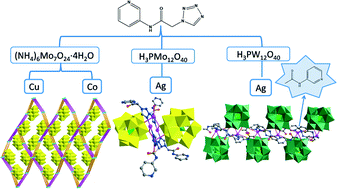Diverse polyoxometalate-based metal–organic complexes constructed by a tetrazole- and pyridyl-containing asymmetric amide ligand or its in situ transformed ligand†
Abstract
By introducing a tetrazole- and pyridyl-containing asymmetric amide ligand into polyoxometalate (POM) systems, four POM-based complexes, namely, H4[Cu2(TAAP)4(H2O)](Mo8O26)2·20H2O (1), H2[Co(TAAP)2(H2O)2](Mo8O26)·11H2O (2), H2[Ag4(TAAP)4(H2O)2(PMo12O40)2]·4H2O (3), and H4[Ag2(AAP)4(PW12O40)2]·2AAP·12H2O (4) (TAAP = 3-(1H-tetrazole-1-acetic acid amido) pyridine; AAP = 3-(acetic acid amido) pyridine), have been prepared under solvothermal (methanol–water mixed solvent) or hydrothermal conditions and structurally characterized. Compounds 1 and 2 are isostructural 3D structures, which are based on 3D [M(TAAP)2]n2n+ metal–organic frameworks and noncoordinated [Mo8O26]4− polyanion templates. Compound 3 exhibits a dimeric structure constructed from two Keggin [PMo12O40]3− anions and a tetranuclear [Ag4(TAAP)4(H2O)2]4+ subunit. Compound 4 exhibits a 2D supramolecular network based on 1D infinite chains, which are constructed by [PW12O40]3− and Ag-AAP subunits. In compound 4, the AAP ligand was in situ transformed from TAAP. The structural diversities show that POMs play key roles in the construction of final architectures and the in situ transformation of TAAP. The title compounds represent the first examples of introducing tetrazole- and pyridyl-containing asymmetric amide ligand into the POM system. The electrochemistry, photocatalysis and photoluminescence properties of the title compounds have been reported.


 Please wait while we load your content...
Please wait while we load your content...